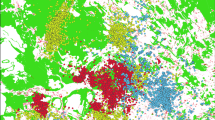Abstract
We studied phenology and density of migrant aerial insectivore birds (Riparia riparia, Hirundo rustica, Delichon urbicum, Apus sp.) from a coastal landscape mosaic of central Italy, in order to detect differences in habitat use and seasonal dynamics of each species. Two habitat types were surveyed: wetlands (a mosaic of reed beds and rush beds) and altered habitats, consisting of orchards and urban areas. We used the point count method from January to June, in a set of randomly selected sampling points. A comparison between all species showed that swifts reached the highest mean point density, while sand martin showed the lowest values, mainly in altered habitats. Initially, all the breeding species were numerous in wetlands; subsequently they shifted toward altered habitats (mainly used as breeding sites), where they were observed up to the end of the counts. Along the Tyrrhenian coast, wetlands are exploited as soon as these aerial foragers arrive in the study area and then shift to the surrounding altered (i.e., urbanized or land reclaimed) zones for nesting after some ten-days.




Similar content being viewed by others
References
Alerstam T (1990) Bird migration. Cambridge University Press, Cambridge
Battisti C (ed) (2006) Biodiversità, gestione, conservazione di un’area umida del litorale tirrenico: la Palude di Torre Flavia. Gangemi Editore, Provincia di Roma, Roma
Batzer DP, Wissinger SA (1996) Ecology of Insect communities in nontidal wetlands. Annu Rev Entomol 41:75–100
Berthold P (1993) Bird migration: a general survey. Oxford University Press, Oxford
Bibby C, Burgess N, Hill D, Mustoe S (2000) Bird census techniques. Academic Press, London
Blasi C, Michetti L (2007) Biodiversità e Clima. In: Blasi C, Boitani L, La Posta S, Manes F, Marchetti M (eds) Stato della Biodiversità in Italia. Ministry for the Environment, Land and Sea Protection. Palombi Editori, Roma, pp 57–66
Boano A, Brunelli M, Bulgarini F, Montemaggiori A, Sarrocco S, Visentin M et al (1995) Atlante degli uccelli nidificanti nel Lazio. Alula 2:1–225
Brichetti P, Fracasso G (2007) Ornitologia italiana vol. 4. Apodidae-Prunellidae. Alberto Perdisa Editore, Bologna
Bruderer B (1979) Der Jahreszyklus schweizerischer Schwalben Hirundo rustica und Delichon urbica unter besonderer Berücksichtigung des Katastrophenjahres. Ornitologische Beobachtungen 76:293–304
Castaldi A, Guerrieri G (1999) La migrazione della Rondine Hirundo rustica lungo la costa laziale. Avocetta 23:41
Cramp S (1988) Handbook of the birds of Europe the Middle East and North Africa. Oxford Univ Press, Oxford
Ehrlich PR, Dobkin DS, Wheye D (1998) The birder’s handbook. Simon and Schuster, New York
Finlayson JC (1979) Movements of the fan-tailed warbler Cisticola juncidis at Gibraltar. Ibis 121:487–489
Fraticelli F (2006) L’estinzione del Topino Riparia riparia nel Lazio. Alula 13:198–199
Gordo O, Sanz JJ (2008) Ecological conditions in the wintering areas were important for White Stork, Cuckoo and Barn Swallow phenology. J Ornithol 149:199–210
Gordo O, Sanz JJ, Lobo JM (2007) Environmental and geographical constraints on common swift and barn swallow spring arrival patterns throughout the Iberian Peninsula. J Biogeogr 34:1065–1076
Guerrieri G, Biondi M, Pietrelli L (1990) Influenza dei parametri meteorologici e ambientali sullo svernamento della Rondine, Hirundo rustica, in Italia centrale. Riv ital Ornit 60:137–147
Gustin M, Sorace A (2004) La migrazione degli Irundinidi lungo la costa delle Marche (Italia centrale). Riv ital Ornit 74:49–53
Hickling RAO (1959) The burrow-excavation phase in the breeding cycle of the sand martin, Riparia riparia. Ibis 101:497–502
Ientile R (1998) Dati sulla biologia riproduttiva del Balestruccio, Delichon urbica, in ambienti urbani. Riv ital Ornit 68:51–56
Malavasi R, Battisti C, Carpaneto GM (2009) Seasonal changes in bird assemblages of a remnant wetland in a cultivated Mediterranean landscape: implications for management. Ornis Hungarica 17–18:25–33
Skagen SK, Knopf FL (1994) Migrating shorebirds and habitat dynamics at a prairie wetland complex. Wilson Bull 106:91–105
Skórka P, Martyka R, Wójcik J (2006) Species richness of breeding birds at a landscape scale: which habitat type is the most important? Acta Ornithol 41:49–54
Smiddy P, Cullen C, O’Halloran J (2007) Time of roosting of Barn Swallows Hirundo rustica at an Irish reedbed during autumn migration. Ringing Migr 23:228–230
Spina F, Volponi S (2008) Atlante delle migrazioni in Italia. Ministero dell’ambiente e della tutela del territorio e del mare ISPRA. Tipografia CSR-Roma, Roma
Sutherland WJ (2004) Ecological census techniques. Blackwell, London
Tews J, Brose U, Grimm V, Tielbörger K, Wichmann MC, Schwager M, Jeltsch F (2004) Animal species diversity driven by habitat heterogeneity/diversity: the importance of keystone structures. J Biogeogr 31:79–92
Waugh DR (1979) The diet of sand Martins during breeding season. Bird Study 26:123–128
Acknowledgments
This study has been performed within the activities of the “Torre Flavia” LTER (Long Term Environmental Research) Station (Environmental Service, Province of Rome). We would like to thank Luca Fortunati and Francesca Causarano for their support during the field surveys, and two reviewers for their useful comments.
Author information
Authors and Affiliations
Corresponding author
Rights and permissions
About this article
Cite this article
Arena, S., Battisti, C. & Carpaneto, G.M. The ecological importance of wetlands for aerial insectivores (swifts, martins and swallows) along the Tyrrhenian coast. Rend. Fis. Acc. Lincei 22, 395–402 (2011). https://doi.org/10.1007/s12210-011-0147-z
Received:
Accepted:
Published:
Issue Date:
DOI: https://doi.org/10.1007/s12210-011-0147-z




